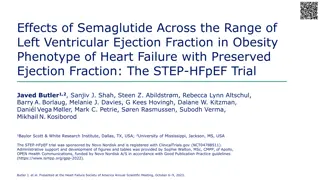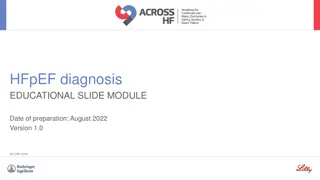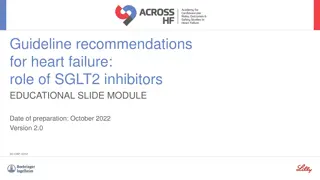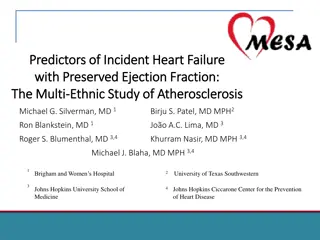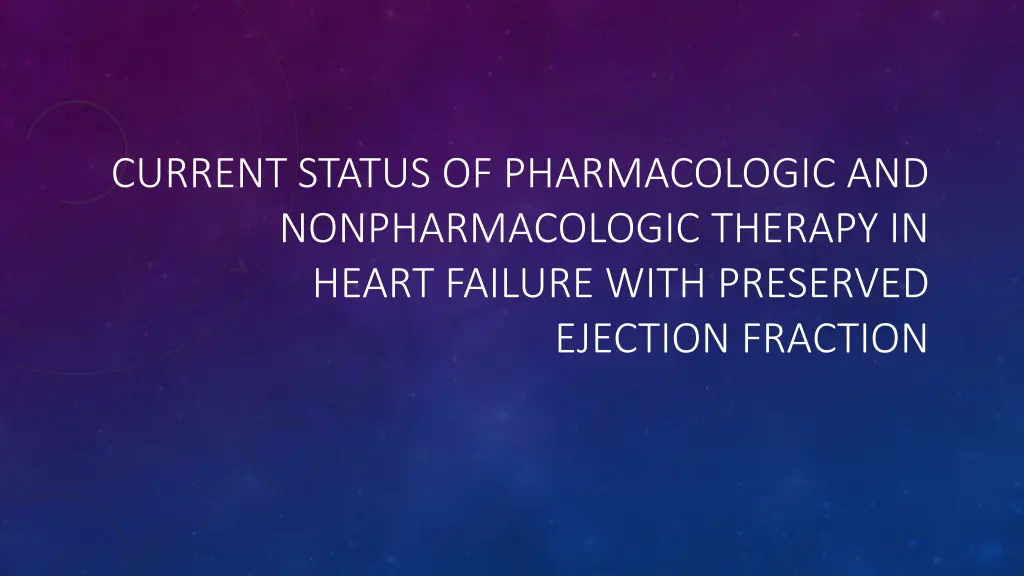
Understanding Heart Failure with Preserved Ejection Fraction
Explore the current status of pharmacologic and nonpharmacologic therapy in heart failure with preserved ejection fraction (HFpEF), the most common form of heart failure. Learn about the lack of proven therapies, the diverse pathophysiologies, and associated comorbidities affecting patients with HFpEF. Discover the challenges and complexities of managing this systemic syndrome to improve outcomes.
Uploaded on | 2 Views
Download Presentation

Please find below an Image/Link to download the presentation.
The content on the website is provided AS IS for your information and personal use only. It may not be sold, licensed, or shared on other websites without obtaining consent from the author. If you encounter any issues during the download, it is possible that the publisher has removed the file from their server.
You are allowed to download the files provided on this website for personal or commercial use, subject to the condition that they are used lawfully. All files are the property of their respective owners.
The content on the website is provided AS IS for your information and personal use only. It may not be sold, licensed, or shared on other websites without obtaining consent from the author.
E N D
Presentation Transcript
CURRENT STATUS OF PHARMACOLOGIC AND NONPHARMACOLOGIC THERAPY IN HEART FAILURE WITH PRESERVED EJECTION FRACTION
INTRODUCTION Heart failure with preserved ejection fraction (HFpEF) is the most common form of heart failure (HF) and accounts for about half the HF cases It lacks proven therapy to reduce mortality and morbidity compared with revolutionized changes in the treatment of HF with reduced ejection fraction (HFrEF) It is a systemic syndrome with diverse phenotypes, various pathophysiologies, and associated with multiple comorbidities
Incidence is progressively increasing 5 year survival:40-50% Females>males Prototype: Elderly female with multiple comorbidities
PATHOPHYSIOLOGY ISCHEMIA OBESITY HYPERTENSION OXIDATIVE STRESS DIABETES AGEING SYSTEMIC INFLAMMATION ENDOTHELIAL DYSFUNCTION ATRIAL FIBRILLATION CHRONIC LUNG DISEASE ANEMIA RENAL DYSFUNCTION MICROVASCULAR DYSFUNCTION
PATHOPHYSIOLOGY : BASIC ETIOLOGIES SYSTEMIC INFLAMMATION IMPAIRED MITOCHONDRIAL FUNCTION MYOCARDIAL INTRACELLULAR CALCIUM OVERLOAD
PATHOPHYSIOLOGY: BASIC ETIOLOGIES SYSTEMIC INFLAMMATION AND OXIDATIVE STRESS INCREASED TGF B FROM MACROPHAGES INTERSTITIAL FIBROSIS
PATHOPHYSIOLOGY : BASIC ETIOLOGIES ENDOTHELIAL DYSFUNCTION AND OXIDATIVE STRESS DOWNREGULATION OF NO-cGMP-PKG PATHWAY REDUCED PROTEIN KINASE G ACTIVATION CARDIOMYOCYTE STIFFENING( Titin)
PATHOPHYSIOLOGY LV DIASTOLIC DYSFUNCTION INCREASED LV FILLING PRESSURE EXERCISE INTOLERANCE AND DYSPNEA
PATHOPHYSIOLOGY ADDITIONAL FACTORS LA DYSFUNCTION PULMONARY HYPERTENSION WITH RV DYSFUNCTION MICROVASCULAR DYSFUNCTION EXTRINSIC RESTRAINT BY EPICARDIAL FAT CHRONOTROPIC INCOMPETENCE HFpEF IMPAIRED VENTRICULOATRIAL COUPLING ABNORMAL CARDIORENAL AXIS LV SYSTOLIC DYSFUNCTION
DIAGNOSIS Diagnosis needs all the four of following 1. Symptoms/signs of heart failure 2. EF>50 3. Positive biomarkers 4. Evidence of structural (LAVI/LVMI) or functional (E/e ) filling abnormalities
PHARMACOLOGICAL MANAGEMENT To date, no treatment has reduced mortality in HFpEF. Optimal volume control and proper management of comorbidities, is the current line on management
ACE INHIBITORS / ARB The RAAS leads to LV hypertrophy and impaired LV diastolic function by increasing arterial and myocardial stiffness CHARM-preserved trial : Composite cardiovascular (CV) death or HF hospitalization was not statistically different in candesartan versus placebo I-PRESERVED : Irbesartan did not reduce all-cause mortality and CV hospitalization and it did not improve the quality of life (QOL) of HFpEF in long-term follow-up
MINERALOCORTICOID RECEPTOR ANTAGONIST Aldo-DHF trial : MRA showed a positive decrease in LV mass, NT- proBNP level, and improved diastolic function but failed to improve HF symptoms, exercise capacity, and QOL in HFpEF SPIRRIT (Spironolactone Initiation Registry Randomized Interventional Trial in Heart Failure with Preserved Ejection Fraction) trial is ongoing
ANGIOTENSIN RECEPTOR NEPRILYSIN INHIBITOR (ARNI) PARAMOUNT HF(Phase 2 trial): In patients with HFpEF, sacubitril-valsartan was associated with a larger reduction of natriuretic peptide levels, LA reverse remodeling, and greater symptom improvement than valsartan Hence PARAGON-HF (Prospective Comparison of ARNI with ARB Global Outcomes in HF with Preserved Ejection Fraction) trial was conducted with a total of 4822 patients
ARNI : PARAGON HF Despite the numerically lower event rate of the primary end points (CV mortality and HF hospitalization), the efficacy of sacubitril valsartan did not achieve statistical significance Sacubitril-valsartan showed the benefit of reducing the primary outcome in female patients with LVEF to less than the median (57%). Preferential benefit in females: Advanced myocardial remodeling even in the same LV systolic function, more progressive age-related arterial stiffening in women / differences in natriuretic peptide signaling.
ARNI Pooled data of PARADIGM HF and PARAGON HF showed benefit existed for LVEF less than 42.5% and it was maximized in patients with lower LVEF. Sacubitril-valsartan was effective in women with LVEF less than or equal to 60% Reduction of the primary end point was maximal in patients recently admitted (within 30 days of prior hospitalization) who had a high risk of rehospitalization and CV death, and it gradually decreased with increasing time from the previous admission.
RATE CONTROL: BETA BLOCKER The increased heart rate by sympathetic overactivation causes shortening of LV diastolic filling time and leads to increased ventricular filling pressure and exercise intolerance Nebivolol did not reduce mortality in patients with HFpEF(LVEF>35%)in SENIORS trial Nebivolol did not improve HF symptoms, exercise capacity, or QOL in the ELANDD trial In J-DHF study, carvedilol was not effective in reducing CV death and HF hospitalization in patients with HFpEF TOPCAT trial : BB was associated with increased HF hospitalization and was not associated with Cv mortality in HFpEF.
RATE CONTROL: IVABRADINE EDIFY (Preserved Left Ventricular Ejection Fraction Chronic Heart Failure with Ivabradine Study) study found no beneficial effects on LV diastolic function, exercise capacity, and natriuretic peptide level despite HR reduction. In a recently reported meta-analysis, ivabradine also did not show improvement in exercise capacity
DIGOXIN In the DIG-PEP (The Effects of Digoxin on Morbidity and Mortality in Diastolic Heart Failure) trial, digoxin did not affect mortality and hospitalization in patients with HFpEF
TARGETING NO-SGC-CGMP-PKG PATHWAY PKGs are intrinsic suppressors of interstitial fibrosis and prevent ventricular hypertrophy via regulation of phosphorylation, structural changes, and oxidation of titin cytoskeletal protein. cGMP, a stimulator of PKG, is generated from guanosine triphosphate by guanylyl cyclase (GCs). GCs exist in 2 forms: the soluble form (sGC) stimulated by NO, and the particulate GC (pGC) stimulated by natriuretic peptides. The downregulation of the NO-sGC-cGMP-PKG pathway is a key mechanism in endothelium cardiomyocyte signaling, altered by pathophysiology of HFpEF
1)DIRECT NITRIC OXIDE DONOR: ORGANIC AND INORGANIC NITRATE NEAT-HFpEF(Nitrate s Effect onActivity Tolerance in Heart Failure with Preserved Ejection Fraction) trial, organic isosorbide mononitrate did not improve QOL or reduce NT-proBNP level but decreased daily activity and worsened HF symptoms. Excessive hypotension caused by vasodilatation and a decrease in cardiac output by preload reduction were possible causes for negative result
Inorganic nitrate (NO3) has a different metabolism of NO via the nitrate-nitrite pathway and might be an important treatment target in HFpEF to improve arterial vasodilatory reserve, increase muscle O2 delivery, and enhance mitochondrial function in skeletal muscle. In small trials, Nitrate delivered via Nitrate-enriched beetroot juice showed an improvement in exercise capacity in the HFpEF population The administration of sodium nitrite via infusion or inhalation improved hemodynamic parameters such as pulmonary artery (PA) pressure during exercise in HFpEF.
INDIE-HFpEF (Inorganic Nitrite Delivery to Improve Exercise Capacity in HFpEF) trial showed that inhaled inorganic nitrite failed to improve HF symptoms,exercisecapacity, and QOL in patients with HFpEF. NO3 via oral administration in HFpEF, suchas KNO3CKOT-HFpEF (Effect of KNO3 Compared to KCl on Oxygen Uptake in Heart Failure With Preserved Ejection Fraction; ) are ongoing.
2)SOLUBLE GUANYLYL CYCLASE STIMULATORS Riociguat and vericiguat enhance cCMP production by acting on NO receptors and are primarily used in the treatment of PH Showed limited efficacy in reducing NT-proBNP and LA size in two phase 2 trials, DILATE-1 and SOCRATES-PRESERVED CAPACITY HFpEF trial and VITALITY-HFpEF ( Vericiguat ) , sGC stimulators failed to improve exercise capacity and QOL in the HFpEF population.
3)PDE 5 INHIBITORS RELAX trial: sildenafil did not improve exercise capacity in patients with HFpEF with or without pulmonary hypertension (PH). In patients with HFpEF and postcapillary PH, sildenafil failed to decrease PA pressure and to improve invasive hemodynamics. However, PDE-5 inhibitor is effective in treating precapillary PH and might offer some benefits in combined precapillary and postcapillary PH
TARGETING INFLAMMATION: INTERLEUKIN-1 INHIBITOR Increased IL-1b level affects calcium homeostasis in cardiomyocytes, increases reactive oxygen species (ROS) production, decreases energy production, and impairs myocardial contractility D-HART :Anakinra, a recombinant IL-1 antagonist, administered for 2 weeks improved peak oxygen consumption in a small number of patients with HFpEF. However, this favorable outcome was not proved in expanded D-HART2 . Anakinra failed to improve aerobic exercise capacity or ventilatory efficiency even though it reduced C-reactive protein (CRP) levels for 12 weeks In the Cardiovascular Risk Reduction Study: Canakinumab, an IL-1b monoclonal antibody, reduced HF-related hospitalization and mortality in a dose-dependent manner
TARGETING MYOCARDIAL FIBROSIS The PIROTTE trial evaluating the clinical efficacy of pirfenidone ( TGF B inhibitor) in the HFpEF population has been completed but the results have not been published yet. AGEs are molecules formed by nonenzymatic reactions between proteins and carbohydrates. Excessive AGE accumulation in myocardial tissue induces cross-linking with other matrix proteins, such as collagen, and leads to interstitial stiffness and progression of myocardial stiffness. Alagebrium is an AGE cross-link breaker that improved LV hypertrophy and LV diastolic dysfunction in patients with diastolic HF.
CELL THERAPY In a murine experiment and a pilot study, cell therapy using cardiosphere- derived cells or CD 34 cells improved LV diastolic dysfunction.
TREATMENT TARGETING CARDIOMETABOLIC PROPERTIES : TARGETING MITOCHONDRIA SS-31 (elamipretide) is a variant of Szeto-Schiller (SS) peptides, which act as cardioprotective antioxidants, reduce ROS production in mitochondria, and prevent maladaptive remodeling Preclinical studies indicated that partial adenosine A1 receptor (A1R) agonists prevented mitochondrial dysfunction of cardiomyocytes under hypoxic conditions by mitochondrial permeability transition. However, the partial A1R agonist neladenoson bialanate failed to improve exercise capacity, QOL, and NT-proBNP level.
TREATMENT TARGETING CARDIOMETABOLIC PROPERTIES : TARGETING INTRACELLULAR CALCIUM Levosimendan is an inodilator that has 1. Positive inotropic action on myocytes by calcium sensitization of troponin C 2. Peripheral vasodilation by opening ATP-sensitive potassium channels on vascular smoothmusclecells. 3. Effect on ATP-sensitive potassium channels on mitochondria 4. Cardioprotective and phosphodiesterase-3 inhibition effects. A clinical study is underway to examine the effect of levosimendan on hemodynamics in patients with HFpEF
TREATMENT TARGETING CARDIOMETABOLIC PROPERTIES : PROSTACYCLIN ANALOGUES Mediates vasodilation of the systemic and pulmonary arteries leading to decreased pulmonary vascular resistance. Prohibits the proliferation of vascular smooth muscle. In the subgroup analysis of the ILO-HOPE trial, inhalation of iloprost before exercise improved LV systolic function, and LV diastolic parameters and estimated PA pressure
SGLT2 INHIBITORS Dapagliflozin, empagliflozin, and canagliflozin has been reported to produce a significant reduction in HF hospitalization and mortality benefit in patients with type 2 diabetes and high CV risk Composite of CV death and hospitalization for heart failure was reduced by a relative 21% with the Empaglifozin inhibitor regardless of presence of diabetes in EMPEROR- Preserved trial. (Dose:10mg OD , ADR: Uncomplicated UTI, hypotension)
Beneficial effect of SGLT2 inhibitors might be derived from the decrease in intravascular volume via osmotic diuresis and natriuresis without RAAS activation and inhibition of the sodium- hydrogen exchanger in the heart and kidney
DELIVER [Dapagliflozin Evaluation to Improve the Lives of Patients with Preserved Ejection Fraction Heart Failure] PRESERVED-HF (Dapagliflozin in Preserved Ejection Fraction Heart Failure)
PRESSURE MONITORING Increased LV filling pressure is a well-known pathophysiology of HFpEF symptoms and signs and is related to HF hospitalization and poor prognosis of HFpEF. The CardioMEMS heart sensor is a wireless pressure sensor implanted in the PA that monitors PA pressure and heart rate.
INTERATRIAL SEPTAL SHUNT The interatrial septal shunt is targeted to reduce the high LV filling pressure and LA pressure. REDUCE LAP-HF 1 :An interatrial septal shunt was effective in decreasing pulmonary capillary wedge pressure (PCWP) during exercise for 1 month, and the efficacy lasted for long-term follow-up without significant complication. REDUCE LAP-HF II trial is currently underway to identify the effects of interatrial septal shunt on clinical outcomes including CV mortality, stroke, HF worsening and hospitalization, and QOL over 1 year.
RATE-ADAPTIVE PACING Chronotropic incompetence plays a key role in impaired cardiac output reserve. Two clinical trials are currently testing the clinical and structural efficacy of rate-adaptive pacing :RAPID-HF and PREFECTUS
CARDIAC CONTRACTILITY MODULATION Cardiac contractility modulation (CCM) is a device therapy for HF that delivers an electrical signal to the RV septal wall in the absolute myocardial refractory period. CCM signals induce mild augmentation of LV contractile strength via alteration of myocardial calcium handling and have some favorable biochemical and molecular effects irrespective of stimulation site.
CARDIAC RESYNCHRONIZATION THERAPY LV dyssynchrony is associated with subtle LV systolic and diastolic functions and increased LV filling pressure
LEFT ATRIAL PACING LA dysfunction is not just a bystander or by-product of increased LV filling pressure but is another key mechanism of HFpEF. Patients with HFpEF have impaired LA systolic and diastolic functions and increased intra-atrial dyssynchrony. The LEAD trial (Left Atrial Pacing in Diastolic Heart Failure) for the evaluation of clinical efficacy of LA pacing has now been completed; results should be available soon.
LEFT VENTRICULAR EXPANDER The CORolla device (Corassist Cardiovascular Ltd, Herzliya, Israel) is designed to increase LV diastolic volume and improve LV diastolic relaxation. The device, consisting of a wire with an elastic spring, is implanted in the LV, and it absorbs energy during systole and releases it during diastole to increase LV filling.
PERICARDIECTOMY If cardiac volume increases and is greater than the reserve volume of pericardial space, the contact pressure by pericardial structure on the surface of the heart also increases. It is transmitted to cardiac chambers, ultimately increasing intracavitary filling pressure. In the experimental data, pericardiectomy was shown to improve diastolic compliance of LV
RENAL SYMPATHETIC DENERVATION Because RSDN leads to decreased LV mass and improved LV diastolic dysfunction, a clinical trial to test the efficacy of RSDN in HFpEF was conducted. This study was terminated early because of difficulty in recruitment and was underpowered to show the therapeutic value of RSDN.
LIFESTYLE MODIFICATION Exercise including endurance and resistance training improved exercise capacity and QOL in patients with HFpEF. The increased body adiposity triggers systemic inflammation and functional impairment of cardiac, vascular, and skeletal muscle Caloric reduction in older and obese patients with HFpEF significantly improved peak O2 consumption, symptoms, and QOL, with an additive benefit from a combination of caloric restriction and exercise
CURRENT APPROACH In acute presentation: Limited diuretic use with vasodilation targeted treatment in acute failure Target BP: <130/80 mmofHg Target HR :65-70 /min Strict volume control in view of poor reserve Management of comorbidities Addressing other cardiac conditions like CAD/AF/valvular disease

